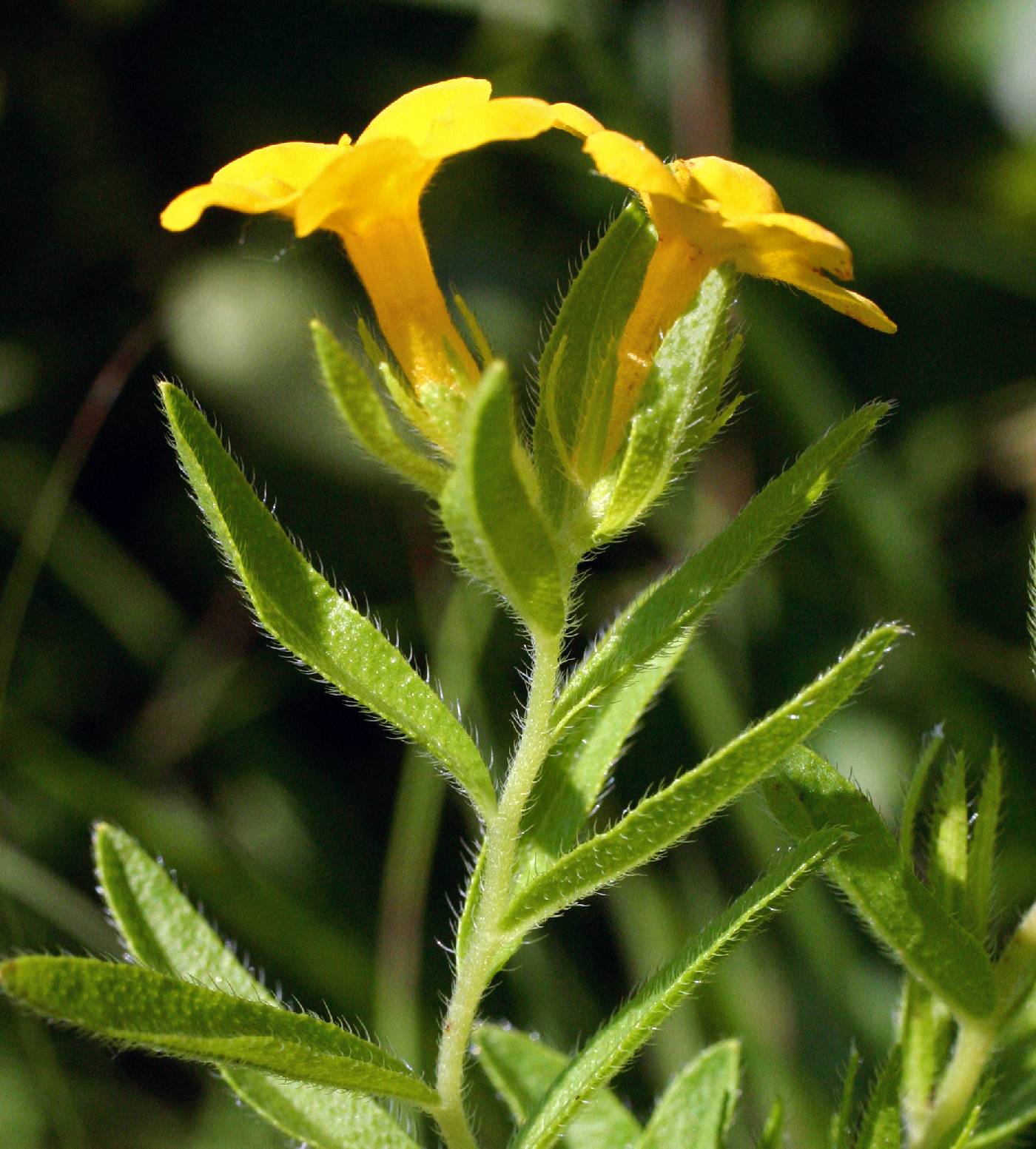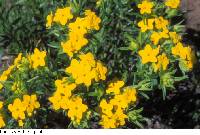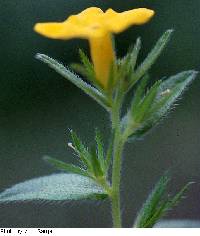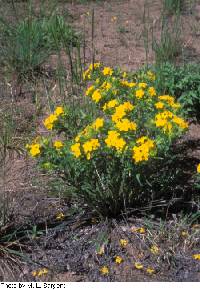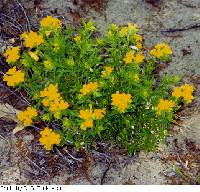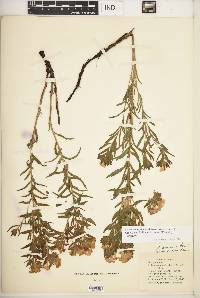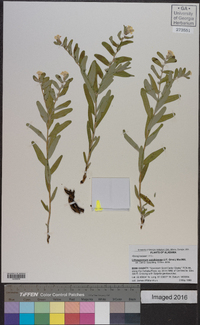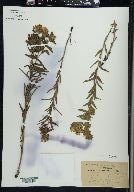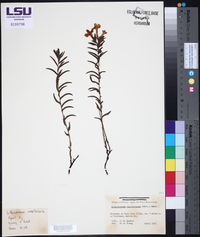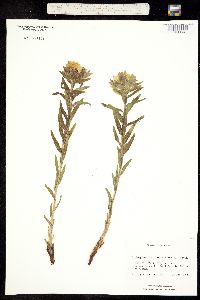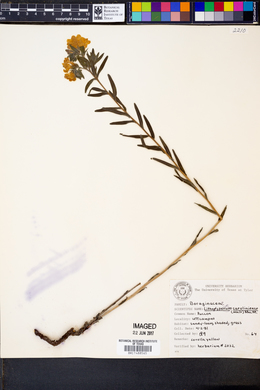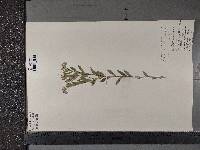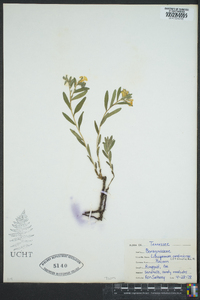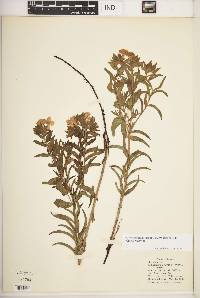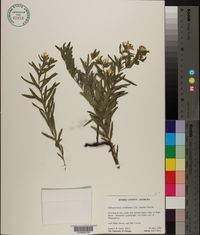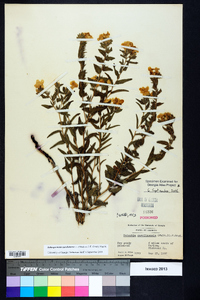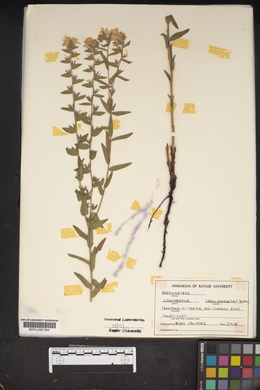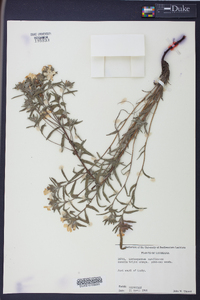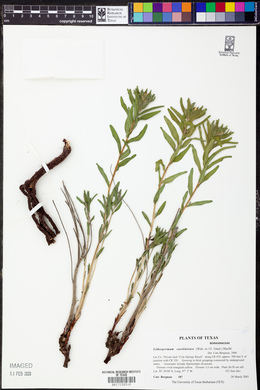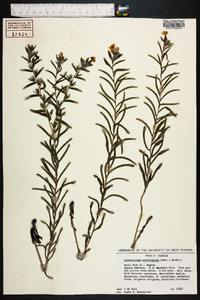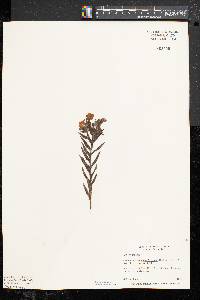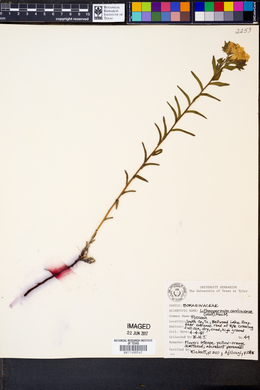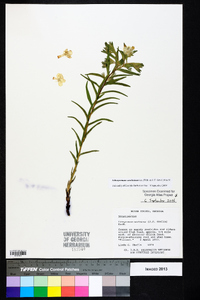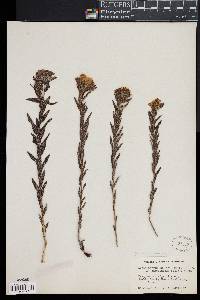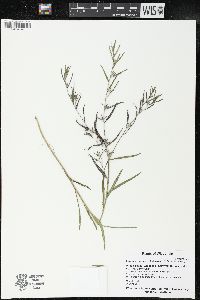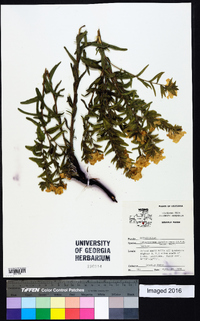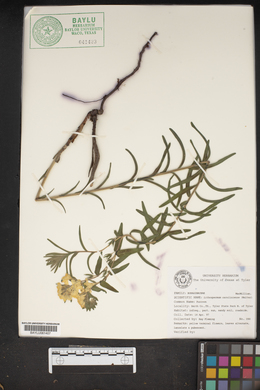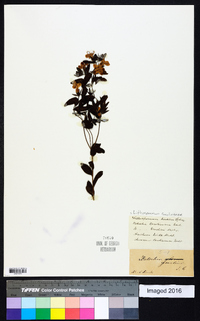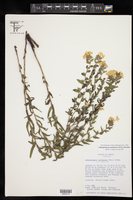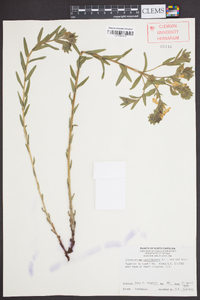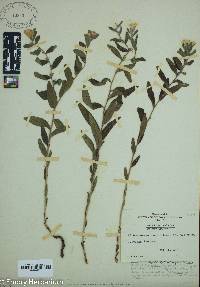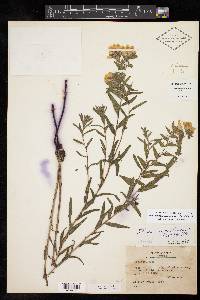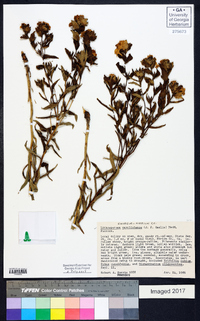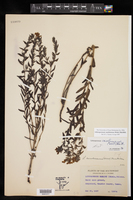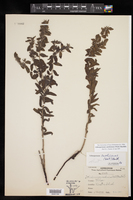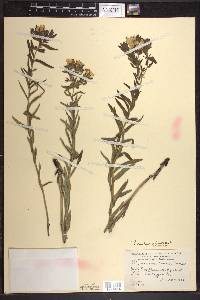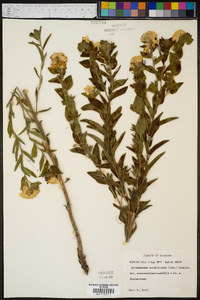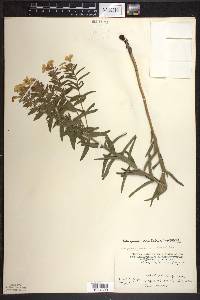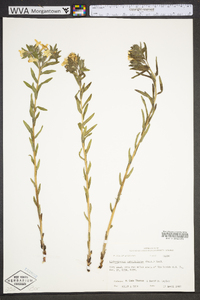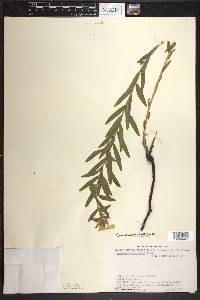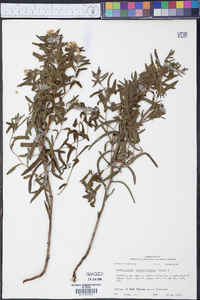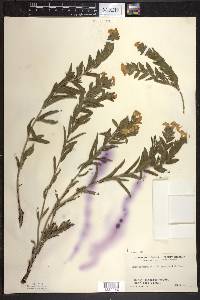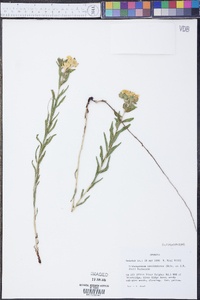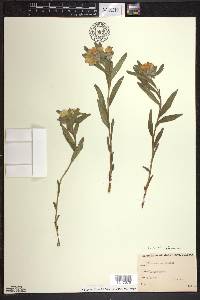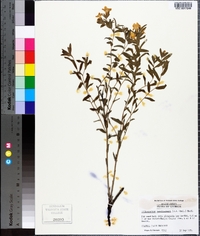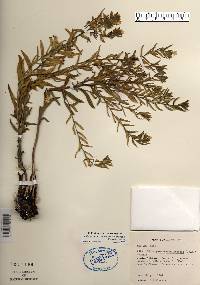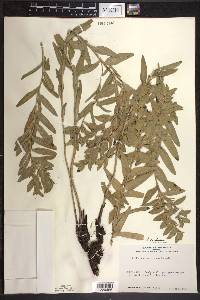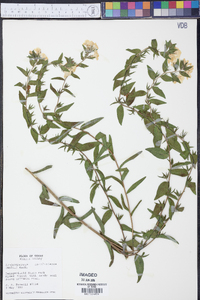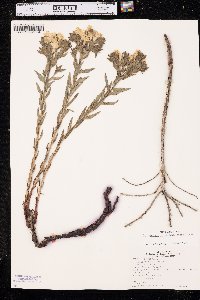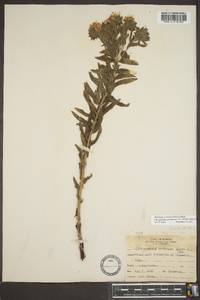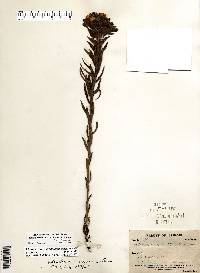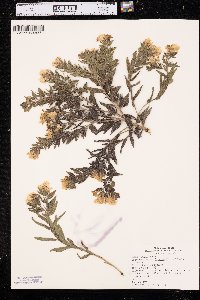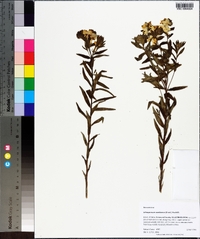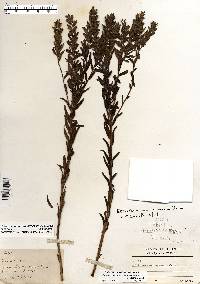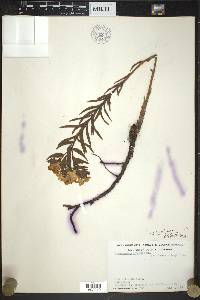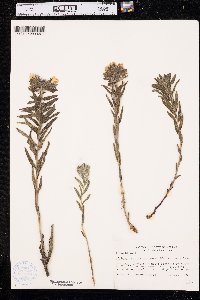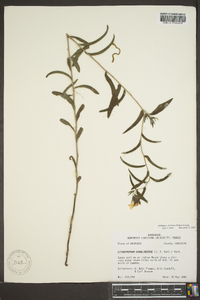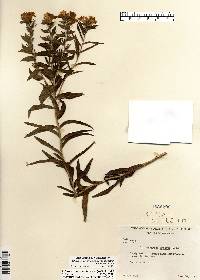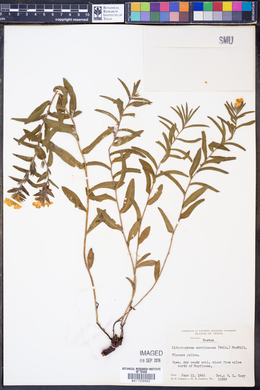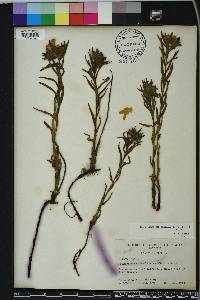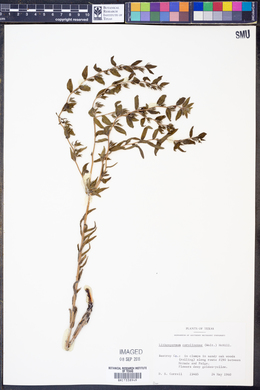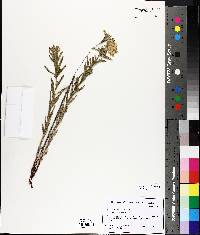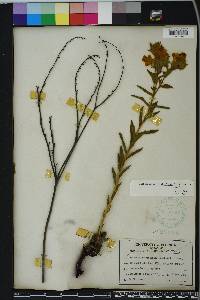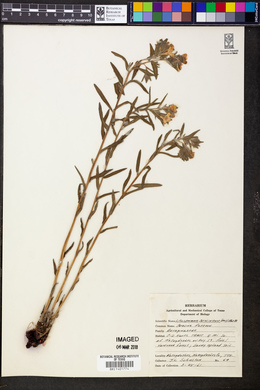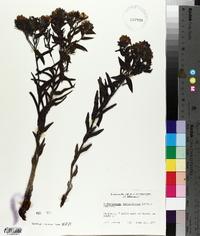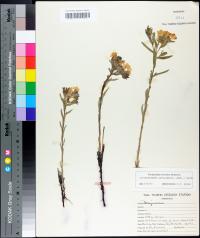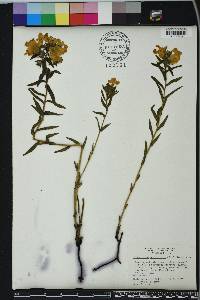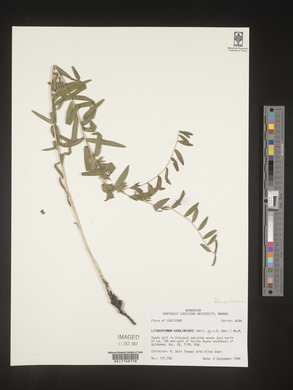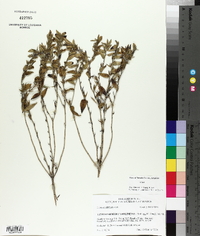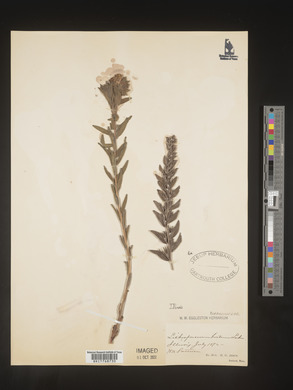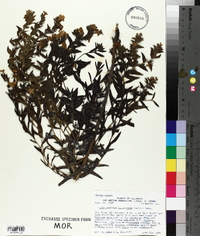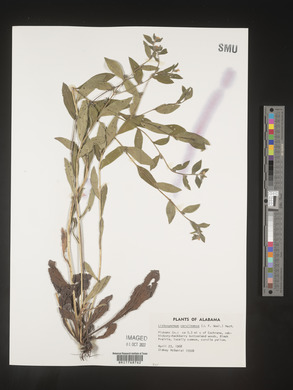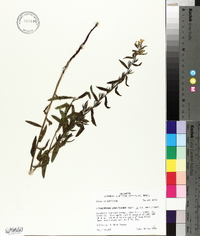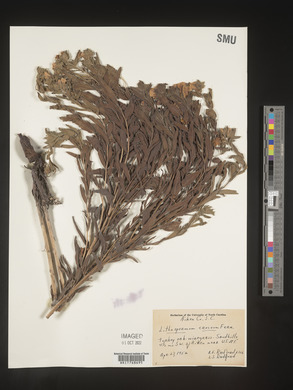
|
|
|
|
Family: Boraginaceae
Hairy Puccoon
|
Perennial herb 30 - 60 cm tall Leaves: typically less than 25 below the inflorescence, alternate, stalkless, non-toothed, firm, without obvious lateral veins, 3 - 6 cm long, over 5 mm wide, linear to lance-shaped, and covered with rough, stiff (occasionally swollen-based) hairs. Inflorescence: several, terminal or subterminal, many-flowered, leafy-bracted, short-branched clusters with short-stalked, bright yellow flowers subtended by overlapping, lance- to egg-shaped, rough bracts. At first the inflorescence is fairly dense and compact, but then it becomes more open and elongate when in fruit. Flowers: bright orange-yellow, 1.5 - 2.5 cm broad, funnel-shaped with 0.7 - 1.4 cm long narrow tube and broad, flaring lobes. Sepals: five, slightly shorter than petal tube, 0.6 - 1 cm long (elongating to 0.8 - 1.3 cm in fruit), very narrow, longer than wide, linear, rough-hairy. Sometimes the sepals may have an obscure lengthwise ridge (keel) running up the outside, and sometimes there may be rough, stiff, somewhat swollen-based hairs on the outer surface mixed in with the regular stiff hairs. Petals: five, but fused for over half their length into a 0.7 - 1.4 cm long, internally hairy (at base) tube, then separating into five, flaring to spreading, 0.7 - 0.9 cm long, fairly oblong to narrowly rounded lobes with blunt tips. Stamens: five, attached to inside of petal tube, but the oblong anthers not extending past the petal tube. Flowers on different plants can have the stamens attached at two different heights depending on the length of the style and position of the stigma: stamens attached low in the petal tube and below the stigma (long-styled) are called short; and stamens attached near the top of the petal tube and above the stigma (short-styled) are called long. Pistil: with one, deeply four-lobed, superior ovary; one, slender style; and one, distinctly two-lobed stigma. The styles of all flowers on a single plant can be either short or long (never mixed on a single plant), but neither type extends past the petal tube. Fruit: a cluster of one to four, erect, shiny, lustrous, ivory-white, hard, bony, smooth, non-pitted, 3.5 - 4 mm tall, egg-shaped nutlets with pointed tips, and rounded base with a central, constricted, collar-like rim. The nutlet clusters are surrounded by the erect to ascending, persistent, 1 - 1.3 cm long sepals. Root: a stout, very long, woody taproot, which if broken or cut exudes a deep purple-red dye. Stems: several (often twelve or more), clustered, erect, sometimes branched above, bristly fuzzy with spreading, often 1 mm long, stiff hairs. Occasionally some hairs may have swollen or inflated bases (pustulate). Similar species: Lithospermum caroliniense in the strict sense is probably very rare in our area since the dominant form in the Chicago Region is L. caroliniense var. croceum, which can be distinguished by its having over 30 leaves below the inflorescence, almost all hairs should have obviously swollen bases (pustulate), and the sepals always have evident raised keels (lengthwise ridges). The other closely similar species is L. canescens, but that species is more softly silky-hairy, the sepals are shorter (typically under 6 mm), the petal lobes are a bit smaller (5 - 6 mm long), and the nutlets are shorter (up to 3 mm). Flowering: April to October Habitat and ecology: Rare in the Chicago Region, but most likely in dry sandy soils. Occurence in the Chicago region: native Notes: The debate over whether our plants form a single variable species of L. caroliniense or whether all of our plants should be classified as L. caroliniense var. croceum is complicated. It is suggested one see the works of Cusick (1985) and Johnston (1952) for more information. Author: The Field Museum Stems erect, clustered (often a dozen or more) on a stout woody root, 3-6 dm at anthesis, very leafy, simple or branched above, villous or hirsute; lvs linear to lanceolate, 3-6 cm, rough-hirsute, the hairs papillate at base in var. croceum; cymes leafy-bracted, at first dense, becoming elongate and racemiform; fls heterostylic; cal-lobes hirsute, linear, 8-11 mm at anthesis, 10-15 mm at maturity; cor bright orange-yellow, the tube 7-14 mm, hairy at base within, the limb 1.5-2.5 cm wide; nutlets ivory-white, smooth and shining. Upland woods, shores, and prairies, especially in sandy soil; sw. Ont. and n. O. to Minn. and Wyo., s. to Ill., Nebr., and Okla. (var. croceum), and from se. Va. to Fla. and Tex. (var. caroliniense). May-July. (L. gmelini; L. croceum) Most of our plants are var. croceum (Fernald) Cronquist, as described above, with keeled cal-lobes and usually more than 30 lvs below the infl. Var. caroliniense, on the se. coastal plain, has flat cal-lobes and usually less than 25 lvs below the infl. Gleason, Henry A. & Cronquist, Arthur J. 1991. Manual of vascular plants of northeastern United States and adjacent Canada. lxxv + 910 pp. ©The New York Botanical Garden. All rights reserved. Used by permission. |
|
|
|

